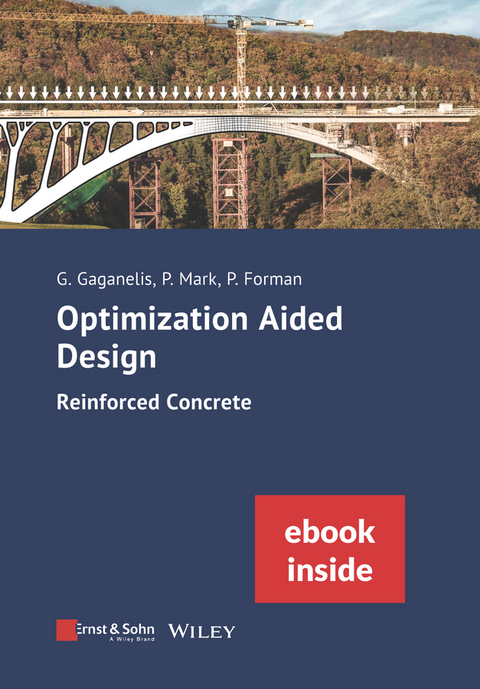
Optimization Aided Design
Ernst & Sohn (Verlag)
978-3-433-03338-8 (ISBN)
Georgios Gaganelis is a structural designer for civil engineering structures and a freelance consultant in structural optimization. 2020 he received his PhD at the Ruhr University Bochum, Germany in the field of optimization strategies for concrete and steel-concrete-composite structures. His research interest focus on topology optimization and material driven steering. A special focus lies on ultra-light structures requiring minimal material efforts. Peter Mark is a full professor for Structural Concrete at the Ruhr University Bochum, Germany. He is researching on applied optimization methods and lightweight concrete structures since 20 years. He received his PhD in 1994 and the post-doctoral degree in 2006. He is Consultant Engineer and Independent Checking Engineer since 2008 and involved in several bridge, tunnel and building construction projects. Patrick Forman is a post-doctoral research fellow at the Institute of Concrete Structures at Ruhr University Bochum, Germany. He received his PhD in 2016. More than 10 years he is researching on lightweight shell and beam structures made of high-performance materials using various structural optimization techniques. Currently, he is technical and managing director of an interdisciplinary research centre on adaptive modularized construction methods.
Foreword by Manfred Curbach
Foreword by Werner Sobek
Preface
Acknowledgments
Acronyms
1 INTRODUCTION
2 FUNDAMENTALS OF REINFORCED CONCRETE DESIGN
2.1 Basic Principles
2.2. Verification Concept
2.3 Safety Concept
2.4 Materials
2.5 Load-bearing Behavior
3 FUNDAMENTALS OF STRUCTURAL OPTIMIZATION
3.1 Structural Optimization Approaches
3.2 Problem Statement
3.3 Lagrange Function
3.4 Sensitivity Analysis
3.5 Solution Methods
4 IDENTIFICATION OF STRUCTURES
4.1 One-material Structures
4.2 One-material Stress-biased Structures
4.3 Bi-material Structures
4.4 Examples
4.5 Applications
5 INTERNAL FORCE FLOW
5.1 Preliminaries
5.2 Continuum Topology Optimization (CTO) Approach
5.3 Truss Topology Optimization (TTO) Approach
5.4 Continuum-Truss Topology Optimization (CTTO) Approach
5.5 Examples
5.6 Applications
6 DESIGN OF CROSS-SECTIONS
6.1 Problem Statement
6.2 Equilibrium Iteration
6.3 Sectional Optimization
6.4 Solving
6.5 Parameterization
6.6 Examples
BIBLIOGRAPHY
LIST OF EXAMPLES
Variation of volume fraction
Variation of the filter radius
Variation of material parameters
Form finding of bridge pylons 1
Form finding of bridge pylons 2
Conceptual bridge design 1
Conceptual bridge design 2
Multi-span girder
Multiple load cases
Two load cases
Material steering
Material variation in bi-material design
Filter radius with bi-material design
Bi-material multi-span girder
Bi-material girder with stepped support
Bi-material arch bridge
Deep beam 1
Wall with block-outs
Corbel
Cantilever beam
Shear transfer at joints
Deep beam 2
Frame corner
Wall with eccentric block-out
Corbel with horizontal force
Stiening core with openings
Deep beam 3
Deep beam 4
Deep beam 5
Strain plane of an unsymmetric RC section
Footing with gapping joint
Parameterized T-section
Parameterized uniaxial bending
Shape design of a RC I-section
Shape optimization of a footing
| Erscheinungsdatum | 09.03.2022 |
|---|---|
| Sprache | englisch |
| Maße | 170 x 244 mm |
| Gewicht | 414 g |
| Themenwelt | Technik ► Bauwesen |
| Schlagworte | Bauingenieur- u. Bauwesen • Baustatik • Baustatik u. Baumechanik • Civil Engineering & Construction • Construction: Sustainability • Nachhaltiges Bauen • Stahlbeton • Structural & Building Engineering • Structural Theory & Structural Mechanics • Structures • Tief- u. Hochbau / Massivbau • Tragwerke |
| ISBN-10 | 3-433-03338-2 / 3433033382 |
| ISBN-13 | 978-3-433-03338-8 / 9783433033388 |
| Zustand | Neuware |
| Haben Sie eine Frage zum Produkt? |
aus dem Bereich


